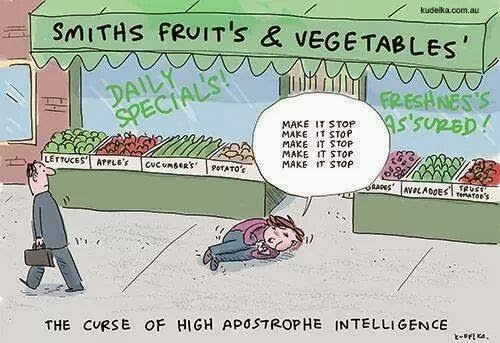You need to know this:
• Apostrophes show two meanings.
• An apostrophe s added to a singular noun shows possession.
• An apostrophe after the s in a plural word shows possession.
• Apostrophes also show where letters were removed.
• Words shortened with apostrophes are called contractions.
Misunderstandings you might harbor:
• Not every word that ends with an s needs an apostrophe.
• You can't rely on chance rather than meaning with the apostrophe.
• We do not use apostrophes to show pronoun possession.
(its, his, mine, ours, hers, theirs, yours)
(its, his, mine, ours, hers, theirs, yours)
BTW: It's a matter of style whether you write 1800's or 1800s.
Utah State Core Standard 2, Objective 2, Correct use of possessives.
Adapted from Jeff Anderson's Everyday Editing
Adapted from Jeff Anderson's Everyday Editing
Another Apostrophe Review
Apostrophe Practice -- Copy the following sentences, selecting the best answer(s) for each.
1. In the school parking lot I saw the
(a. Long’s, b. Longs’, c. Longs’s) car,
the (a. Phillip’s , b. Phillips’, c. Phillips’s) van,
and the (a. Batemen’s, b. Bateman’s, c. Batemans’ ) pickup.
[Notes: The family names above are Long, Phillips, and Bateman. Consider each vehicle as if it belongs to the whole family.]
2. My (a. uncles, b. uncle’s, c. uncles’) car is a Hummer. (I have only one uncle.)
3. My (a. uncles, b. uncle’s, c. uncles’) car is a Hummer. (I have two uncles who share the Hummer.)
4. All of my (a. uncles, b. uncle’s, c. uncles’) own great cars. (I have several uncles.)
_____________________________________________
Extra credit opportunity: Find apostrophes uses correctly in published text -- newspapers, magazines, etc. circle the words, and bring me the original or a copy.
_________________________________________




